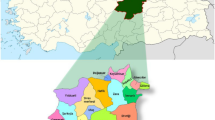Abstract
Folk names and uses for martyniaceous plants are detailed by literature references, data from herbarium specimens and fieldwork in Mexico and the United States. There is a diversity of names and uses in Mexico because of the large number of species and the many different cultures there. Seeds, roots, and leaves of species ofProboscidea are gathered and consumed as food. Leaves ofMartynia are used to remove insects from fowl in Mexico and Guatemala, and its fruits are used medicinally in the former country. Most Mexican common names for martyniaceous plants are descriptive, and the folk taxonomies for these plants often agree with scientific taxonomies. The showy and fragrant flowers and oddly-shaped fruits ofProboscidea, Ibicella, andMartynia led to their cultivation as ornamentals in the United States and Europe. The common names for martyniaceous plants in European languages are generally variations of devil’s claw, cat’s claw, or unicorn plants. Young fruits ofProboscidea andIbicella are eaten as vegetables and pickles in the United States, South America, and Europe. Mature fruits ofProboscidea are widely used as ornaments. Roots from species ofCraniolaria are consumed as food or medicine in South America and the Antilles.
Similar content being viewed by others
Literature Cited
Abbiatti, D. 1939. Las Martiniáceas Argentinas. Not. Mus. La Plata (Botánica) Tomo 4, #29: 443–473.
Alvarado, L. 1929. Glosarios del Bajo español en Venezuela. Lito-Tip, Mercantil, Caracas.
Anonymous. 1847. Martynia fragrans. Bot. Mag. 73: t. 492.
Anonymous. 1980. Flower and Vegetable Garden Catalog. G. W. Park Seed Co., Greenwood, SC.
Barrera Marin, A., A. Barrera Vasquez, and R. M. Lopez Franco. 1976. Nomenclature Etnobotanica Maya #36 de la Coleccion Científica. Instituto Nacional de Antropologia e Historia, Mexico, Mexico, D. F.
Bergen, F. D. 1894. Glimpses of the Plant World. Ginn, Boston.
Berlin, B., D. E. Breedlove, and P. H. Raven. 1974.Principles of Tzeltal Plant Classification. Academic Press, New York.
Berry, J., P. K. Bretting, G. Nabhan, and C. Weber. 1981.Proboscidea parviflora: a potential oilseed plant for aridlands. J. Arid Environ. 4: 147–160.
Bretting, P. K. 1981. A systematic and ethnobotanical survey ofProboscidea (Martyniaceae) and allied genera. Unpub. Ph.D. Diss., Indiana Univ., Bloomington.
—. 1982. Morphological differentiation ofProboscidea parviflora ssp.parviflora (Martyniaceae) under domestication. Amer. J. Bot. 69: 1531–1537.
Cook, O. F., and G. N. Collins. 1903. Economic plants of Porto Rico. Contr. U.S. Natl. Herb. 7: 57–269.
Cronquist, A. 1981. An Integrated System of Classification of Flowering Plants. Columbia Univ., Press, New York.
Felger, R., and M. B. Moser. 1976. Seri Indian food plants: desert subsistence without agriculture. Ecol. Food and Nutr. 5: 13–27.
Garcia Barriga, H. 1975. Flora Medicinal de Colombia. Tomo Tercero, Instituto de Ciencias Naturales, Bogotá.
Gentry, H. S. 1963. The Warihio Indians of Sonora-Chihuahua: An ethnographic survey. Bur. Amer. Ethnobiol. Bull. 186 (Anthropol. Pap. 65): 61–144. Smithsonian Institution, Washington, DC.
Gerth Van Wijk, H. 1911–1916. A Dictionary of Plant Names. 2 vol. Dutch Soc. Sciences at Haarlem. Martin Nijhoff, The Hague.
Ghosh, L., and J. L. Beal. 1979. Seed lipid constituents of three species ofProboscidea. J. Nat. Prod. 42: 287–292.
Harrington, H. D. 1967. Edible Native Plants of the Rocky Mountains. Univ. New Mexico Press, Albuquerque.
Hernández, F. 1959. Historia Natural de Nueva España. Univ. Nac. de México, Mexico, D. F.
Kirk, D. R. 1970. Wild Edible Plants of the Western United States. Naturegraph Publishers, Happy Camp, CA.
Martínez, M. 1959. Las Plantas Medicinales de Mexico. 4 to. Ed. Editorial Botas, Mexico, D. F.
McAtee, W. L. 1938. Journal of Benjamin Smith Barton on a visit to Virginia, 1802. Castanea 3:85–117.
Messer, E. 1978. Zapotec Plant Knowledge: Classification, Uses, and Communication about Plants in Mitla, Oaxaca, Mexico.In Prehistory and Human Ecology of the Valley of Oaxaca. K. V. Flannery and R. S. Blanton, gen. ed., vol. 5, part 2. Mem. Mus. Anthropol., Univ. Michigan, #10, Ann Arbor.
Miller, P. 1768. The Gardener’s Dictionary. 8th ed. Published for the author, London.
Morton, J. F. 1975. Current folk remedies of northern Venezuela. Quart. J. Crude Drug Res. 13: 97–121.
Nabhan, G., A. Whiting, H. Dobyns, R. H. Hevly, and R. Euler. 1981. Devil’s claw domestication: evidence from Southwestern Indian fields. J. Ethnobiol. 1:135–1644.
Pennington, C. W. 1963. The Tarahumar of Mexico: Their Environment and Material Culture. Univ. Utah Press, Salt Lake City.
—. 1969. The Tepehuan of Chihuahua: Their Material Culture. Univ. Utah Press, Salt Lake City.
Risquez, F. A. 1895. Terapeutica y la Flora Americana. Address presented at 1st Pan American Medical Congress, Sept. 5–8, 1893.In Trans. 1st Pan American Medical Congress, p. 69–85. Gov. Printing Office, Washington, DC.
Santamaria, F. J. 1942. Diccionario General de Americanismos. Primero ed. 3 Tomos. Ed. Pedro Robredo, Mexico, D. F.
-. 1974. Diccionario de Mejicanismos. 2 do. Ed. Editorial Porrua, Mexico, D. F.
Sturtevant, E. 1972. Sturtevant’s Notes on Edible Plants (U. P. Hedrick, ed) Report New York Agric. Exp. Sta. 27, vol. 2, pt. 2. Albany, NY.
Thieret, J. 1977. The Martyniaceae in the southeastern United States. J. Arnold Arbor. 58: 25–39.
Turner, N. J. 1974. Plant taxonomic systems and ethnobotany of three contemporary Indian groups of the Pacific Northwest (Haida, Bella Coola, Lilloet). Syesis 7: (Suppl. 1).
Van Eseltine, G. 1929. A preliminary study of the unicorn plants (Martyniaceae). New York Agric. Exp. Sta. Techn. Bull. #149.
Vilmorin-Andrieux, M. M. 1885. The Vegetable Garden. Illustration, Descriptions, and Culture of the Garden Vegetables of Cold and Temperate Climates. Jeavons-Leler, Paris.
Author information
Authors and Affiliations
Rights and permissions
About this article
Cite this article
Bretting, P.K. Folk names and uses for martyniaceous plants. Econ Bot 38, 452–463 (1984). https://doi.org/10.1007/BF02859087
Received:
Accepted:
Issue Date:
DOI: https://doi.org/10.1007/BF02859087




